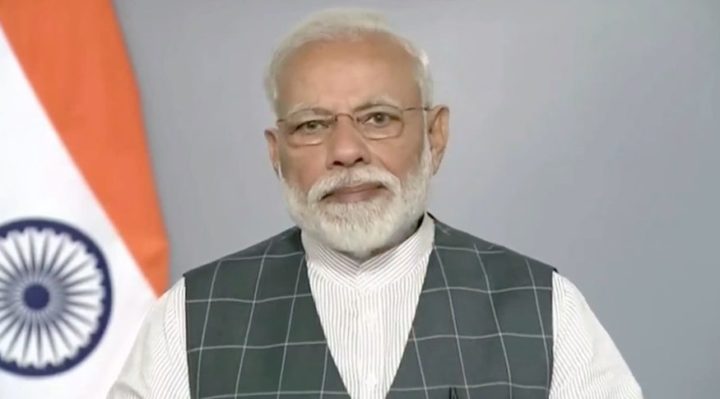The Indian government announced March 27 it successfully fired a ground-based anti-satellite weapon against a satellite in low Earth orbit, a test that is likely to heighten concerns about space security and orbital debris.
Indian Prime Minister Narendra Modi said that the country’s military successfully demonstrated an anti-satellite (ASAT) weapon in a test known as “Mission Shakti.” In that test, a ground-based missile, a version of an existing ballistic missile interceptor, hit a satellite at an altitude of about 300 kilometers.

“It shows the remarkable dexterity of India’s outstanding scientists and the success of our space programme,” Modi said in a series of tweets announcing the test. Modi also made a televised announcement, in Hindi, about the test.
According to a statement from India’s Ministry of External Affairs, the missile was launched from the Dr. A P J Abdul Kalam Island launch complex in the northeast part of the country. The missile struck an unidentified Indian satellite. “The test was fully successful and achieved all parameters as per plans,” the ministry stated.
Neither Modi nor the ministry identified the satellite targeted by the test. Indian media speculated that the likely targets were either Microsat-R, launched in January, or Microsat-TD, launched a year earlier. Microsat-R is in a 262-by-280-kilometer orbit, while Microsat-TD is in a 353-by-361-kilometer orbit, according to tracking data by the U.S. military.
The ministry said in its statement that the test was designed to minimize long-lived debris. “The test was done in the lower atmosphere to ensure that there is no space debris. Whatever debris that is generated will decay and fall back onto the earth within weeks.” It wasn’t immediately known how much debris the test generated, but some debris may end up in higher orbits with longer decay times.
The test makes India the fourth country, after the United States, Russia and China, to test an ASAT weapon. Modi and his government said that the test both demonstrated the capabilities of India’s overall space program as well as showed its willingness to defend its satellites against attacks.
“The test was done to verify that India has the capability to safeguard our space assets,” the ministry said in its statement. “It is the Government of India’s responsibility to defend the country’s interests in outer space.”
“India stands tall as a space power!” Modi declared. “It will make India stronger, even more secure and will further peace and harmony.”
The test, though, could increase concerns about the security of space assets in general. A February report by the Defense Intelligence Agency highlighted efforts by China and Russia to develop ASAT capabilities, including both ground-based missiles and other technologies, although neither country has performed a debris-generating test since China destroyed one of its own satellites with a ground-based missile in 2007, generating a large amount of debris that triggered international criticism.
The United States performed its own similar test in February 2008, destroying the USA 193 satellite using a modified version of a ship-based SM-3 missile in a test called Operation Burnt Frost. The satellite was in an orbit about 250 kilometers high when it was successfully intercepted, and the U.S. government, which announced the test in advance, said it was designed to minimize the creation of debris. Most of the debris from that test did reenter within weeks, although the last piece of debris tracked from that test remained in orbit until late 2009.
China surpassed the United States in the total number of space launches for 2018, with 38 compared to 34, and showcased its technological advancements by landing a rover on the back side of the moon.
China’s SJ-17 satellite continued testing remote proximity operations in early 2018 around two other Chinese satellites.
China appears to have placed truck-mounted jammers on Mischief Reef in the Spratly Islands in 2018.
In June 2018, Symantec reported a sophisticated hacking campaign from China that targeted satellite operators, defense contractors and telecommunications companies.
Russia conducted its seventh test of the PL-19 Nudol direct ascent anti-satellite system in December 2018 using a mobile launching system.
A picture surfaced in September 2018 showing a Russian MIG-31 fighter jet carrying what is believed to be a mock-up of an air-launched anti-satellite missile.
In September 2018 it was reported that Russia is developing a suspected new co-orbital anti-satellite system known as Burevestnik designed for operations in geosynchronous Earth orbit.
France in September complained publicly about Russian remote proximity operations near a French-Italian military satellite.
Russia has been actively using its electronic counterspace systems to jam GPS signals around Norway and Finland for multiple NATO and allied military exercises, including Trident Junction 18 and Exercise Clockwork in January 2019.
On India’s recent ASAT test, The Indian government had boasted for years that it had a direct ascent anti-satellite capability, but this was the first time it actually demonstrated that capability. “While the test does not initially appear to be as bad for the space environment as the Chinese test in 2007, it nevertheless produced thousands of pieces of debris, some of which may linger in orbit for decades and pose a threat to other satellites,”.
“The test clearly establishes India as a space rival to countries like China and as an important player to be included in future negotiations of conduct in space,”. The purpose of the test, however, may have been as much about domestic politics as about making a geopolitical statement.
In the foreword to the CSIS report, Rep. Jim Cooper (D-Tenn.) argues that the space security environment is a key reason why the United States should have a Space Force as a separate military branch. Cooper is the chairman of the House Armed Services Committee’s strategic forces subcommittee and a longtime advocate of a military space service.
“The United States is not the leader in anti-satellite technology,” Cooper writes. “We had naively hoped that our satellites were simply out of reach, too high to be attacked, or that other nations would not dare.” But counterspace weapons are now a reality and the Pentagon “has done very little to reduce this existential risk,” he adds.
“This is the year of decision,” states Cooper. “The president has recently demanded a Space Force. The Pentagon has responded with a proposal and this year’s National Defense Authorization Act “will decide the outcome.”

Report released by SWF
The Secure World Foundation’s “Global Counterspace Capabilities: An Open Source Assessment,” edited by Brian Weeden and Victoria Samson, also focuses on advances made by China and Russia. And it includes preliminary details about India’s ASAT test after a prior failure in February 2019.
Like the CSIS report, the SWF study draws from publicly available information. It includes sections on Chinese and Russian directed-energy weapons capabilities and programs, and on both nations’ recent changes to their military space and counterspace organizations.
Russian rendezvous proximity operations in low Earth orbit of late suggest they are part of a space situational awareness program known as Nivelir that may be supporting the co-orbital Burevestnik project, both of which may have begun in 2011, the report reveals. SWF found new evidence that Russia may be upgrading the Krona optical space-based surveillance system with laser dazzling or blinding capabilities.
The militarization of space is a concern, the SWF report says. “A growing number of countries and commercial actors are getting involved in space, resulting in more innovation and benefits on Earth, but also more congestion and competition in space.”
More countries are looking to use space to enhance their military capabilities and national security, and are developing counterspace technologies that can be used to deceive, disrupt, deny, degrade or destroy space systems, says the report.
“The existence of counterspace capabilities is not new, but the circumstances surrounding them are,” according to SWF. There are more incentives to develop offensive counterspace capabilities and greater potential consequences from their use as the global economy and society become more reliant on space applications.”



